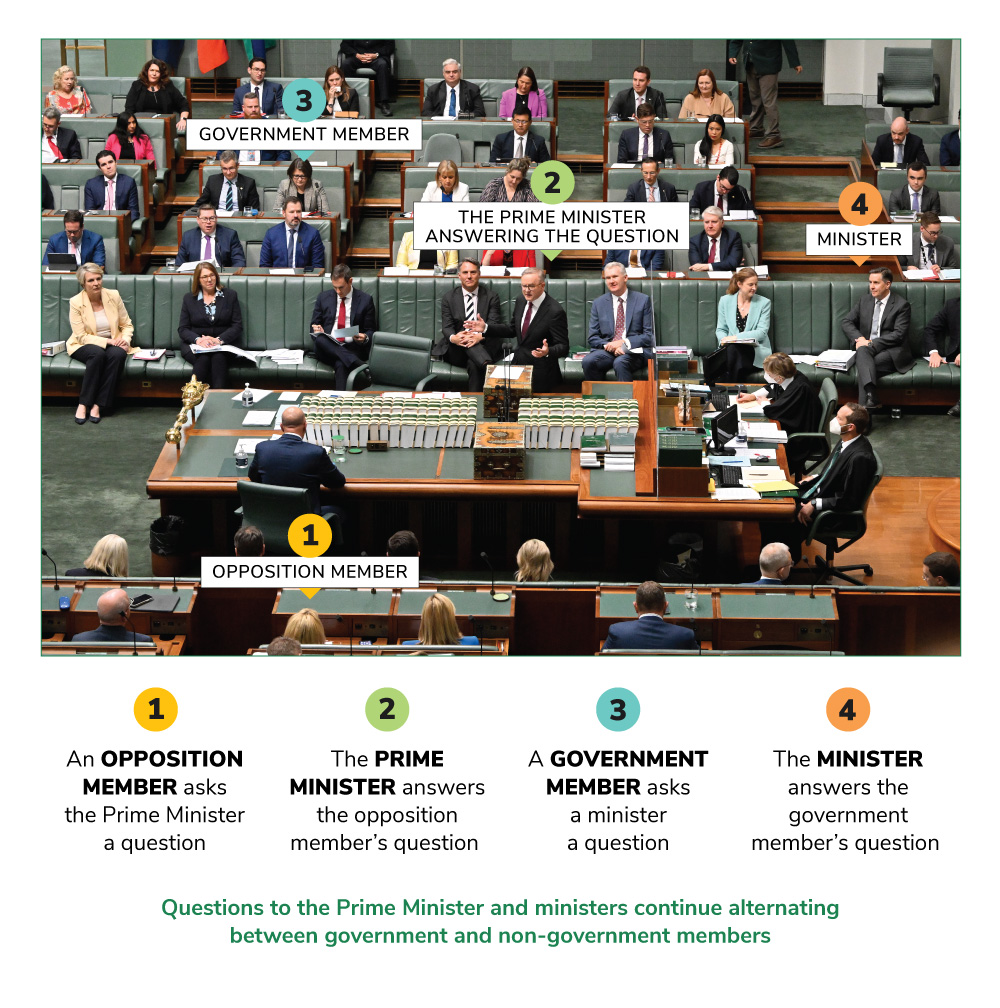Question Time
This fact sheet explores Question Time, the time when the Australian Parliament examines the work of the government by asking them questions. It happens each sitting day in the Senate and the House of Representatives.
What will I learn?
- Question Time is when members of parliament ask questions of government ministers who must immediately answer.
- Question Time happens at 2pm each sitting day in the Senate and the House of Representatives.
What is Question Time?
Question Time in the House of Representatives. Parliamentary Education Office (peo.gov.au), DPS AUSPIC Parliamentary Education Office (peo.gov.au), DPS AUSPIC This image shows the main people involved in Question Time in the House of Representatives. In the centre there is a T-shaped table with the Leader of the Opposition sitting opposite the Prime Minister who is standing to speak. There are tiers of seating behind the Prime Minister with members of the government seated in them. Members of the opposition sit behind the Leader of the Opposition. This work is licensed under a Creative Commons Attribution-NonCommercial-NoDerivs 3.0 Unported License. You are free to share – to copy, distribute and transmit the work. Attribution – you must attribute the work in the manner specified by the author or licensor (but not in any way that suggests that they endorse you or your use of the work). Non-commercial – you may not use this work for commercial purposes. No derivative works – you may not alter, transform, or build upon this work. Waiver – any of the above conditions can be waived if you get permission from the copyright holder. Question Time is when members of parliament ask ministers questions in the Senate and the House of Representatives. Question Time allows the opposition and other members of parliament to attempt to hold the government to account for its actions and to highlight the political issues of the day.
Question Time is when members of parliament ask ministers questions in the Senate and the House of Representatives. Question Time allows the opposition and other members of parliament to attempt to hold the government to account for its actions and to highlight the political issues of the day. Question Time in the House of Representatives.

Description
Copyright information
Question Time is one of the ways the Australian Parliament scrutinises – closely examines – the work of the Australian Government. Ministers are asked to explain their actions and decisions taken in their portfolios – areas of government responsibility. Question Time also gives ministers an opportunity to present their ideas, demonstrate their leadership abilities and refine their political skills.
How is it run?
Since the first Parliament in 1901, time has been set aside to allow questions to be asked of ministers. Question Time is run according to the standing orders of the Senate and the House of Representatives. It occurs at 2pm every day when Parliament is sitting and usually lasts for about 1 hour.
Question Time begins with the President of the Senate or Speaker of the House of Representatives asking, 'Are there any questions?’ The first question always comes from the opposition. The government and opposition take turns putting questions to the Prime Minister or ministers. Minor party and independent – Crossbench – members of parliament are also given the opportunity to ask questions.
Question Time can be loud and fiery, with plenty of lively debate and interruptions. All senators and members of the House of Representatives attend Question Time and the press gallery is always there to report on what is discussed.
Question Time can be watched live and is recorded so all Australians can view or read what happens.
Questions without notice
During Question Time, the ministers do not know what questions they will be asked by the opposition or crossbench. These spoken questions are called questions without notice. They are likely to be tough and are designed to test the ministers' ability to answer immediately and confidently.
Government backbenchers also ask ministers questions to highlight government policies and achievements. These questions and answers are prepared before Question Time and are known as Dorothy Dixers, after a magazine columnist who used to write her own questions and answers.
Questions on notice
At the end of Question Time, the Prime Minister in the House of Representatives and the Leader of the Government in the Senate will ask 'that further questions be placed on the Notice Paper'. This allows any outstanding questions to become questions on notice.
Questions on notice are written questions directed to ministers by members of parliament. They are placed on the Notice Paper – the daily agenda – and answered in writing by ministers. These questions are used to find out more detailed or statistical information about government policy and actions on particular issues. The minister is expected to answer the questions within 30 days and can be asked to provide an explanation for any delay after this period. These questions and answers are not read out, but they are published in Hansard.
